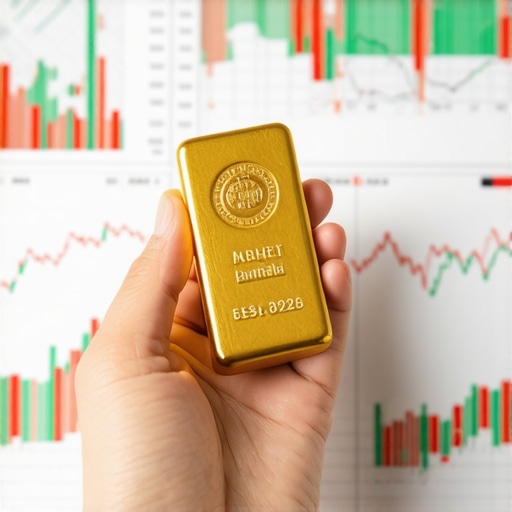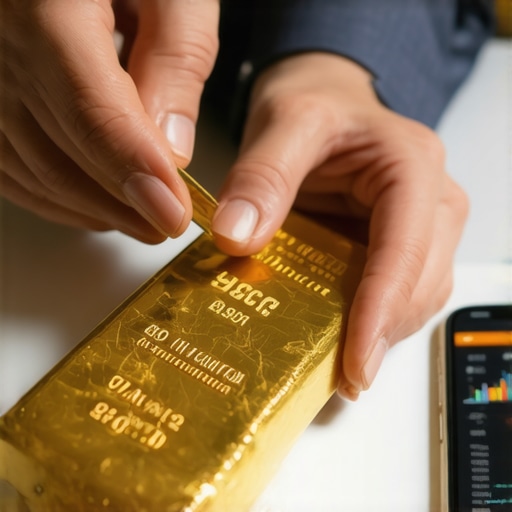Unlocking the Golden Gateway: Why Beginners Should Consider Gold Investment
Dipping your toes into the world of investing can feel daunting, especially with precious metals like gold, which carry an aura of mystery and age-old value. But for beginners, investing in gold offers a unique blend of stability, liquidity, and diversification potential that is unmatched by many other asset classes. Understanding the nuances before buying is crucial to turn this gleaming metal into a robust component of your financial portfolio.
Beyond the Shine: The Multifaceted Nature of Gold Investments
Gold investment is not monolithic. It spans physical assets like bullion bars and coins, as well as financial instruments such as ETFs, mutual funds, and stocks linked to gold mining companies. Each type carries distinct risk profiles, liquidity considerations, and market dynamics. For instance, physical gold offers tangible ownership but requires secure storage, while gold ETFs provide ease of trading but expose investors to market volatility differently. Beginners must weigh these factors carefully to align their choice with investment goals and risk tolerance.
How Can Beginners Navigate the Risks and Rewards of Buying Gold?
Understanding market conditions is pivotal. Gold often serves as a hedge against inflation and currency fluctuations, but its price can be influenced by central bank policies, geopolitical tensions, and global demand-supply shifts. A novice investor should consider timing, purchase method, and authenticity verification to mitigate common pitfalls such as overpaying premiums or buying counterfeit products. Utilizing reputable dealers and learning to assess purity marks and certification can safeguard your investment.
The Art and Science of Choosing Your First Gold Investment
Beginners should start with clear objectives—are you aiming for long-term wealth preservation, portfolio diversification, or speculative gains? Physical gold such as coins or bars can be a prudent start, providing direct exposure and emotional satisfaction of possession. Alternatively, gold ETFs offer accessibility and lower transaction costs, making them appealing for those wary of physical custody. For deeper insights, resources like this guide on choosing your first bullion provide expert advice tailored for newcomers.
Expert Tips to Safeguard and Grow Your Gold Investment
Diversification within gold investments can optimize returns and reduce risks. Combining physical gold with gold stocks or ETFs can balance liquidity and growth potential. Staying informed about market trends and regulatory changes is necessary; for example, central bank gold purchases significantly impact global prices, as detailed by the World Gold Council’s annual report (Gold Demand Trends). Regularly reviewing your portfolio’s gold allocation ensures alignment with evolving financial goals and market conditions.
Join the Conversation: Share Your Gold Investment Experience
Whether you are just starting or have navigated the golden markets for years, your insights enrich the community. Share your experiences, questions, or tips in the comments below to help fellow beginners embark on a more informed and confident investing journey.
Decoding Market Volatility: How Gold Reacts to Economic Shifts
Gold’s reputation as a safe haven is well-earned; however, its price movements can be intricate, influenced by a mosaic of global economic indicators and investor sentiment. For beginners, understanding these triggers is essential for making informed decisions beyond the simplistic view of gold as just a refuge during turmoil. Factors such as interest rate changes, inflation expectations, and geopolitical events create ripple effects that impact gold’s demand and supply dynamics. For instance, rising interest rates often push bond yields higher, making non-yielding assets like gold less attractive, whereas inflationary pressures typically boost gold’s appeal as a store of value.
Moreover, central bank policies play a crucial role. When central banks increase their gold reserves, it signals confidence in gold’s long-term stability, often leading to price appreciation. Conversely, large-scale sales can depress prices temporarily. Staying attuned to such macroeconomic signals allows investors to anticipate market turns and align their gold holdings accordingly.
Integrating Gold into a Diversified Portfolio: Practical Approaches
While gold’s diversification benefits are widely recognized, the optimal allocation varies depending on individual risk tolerance, investment horizon, and financial goals. Experts often recommend allocating between 5% to 15% of a portfolio to gold-related assets to balance growth and protection effectively. Physical gold provides tangible security and acts as a hedge against currency devaluation, but it may lack liquidity compared to financial instruments like gold ETFs or gold mining stocks.
Investors should also consider combining different gold investment types to capture various market opportunities. For example, gold mining stocks can offer leveraged exposure to gold prices, potentially amplifying returns during bullish cycles but with higher volatility. Meanwhile, gold ETFs provide easy access and cost efficiency, ideal for those seeking flexibility without the hassle of physical storage. Resources such as this comprehensive overview of gold investment types delve deeper into these options.
What Are the Emerging Trends in Gold Demand That New Investors Should Monitor?
Emerging trends in gold demand are reshaping the investment landscape, offering both challenges and opportunities for newcomers. Technological advancements, such as increased use of gold in electronics and medical applications, are gradually influencing industrial demand. Additionally, the rising interest in sustainable and ethical sourcing is prompting shifts in consumer preferences and supply chain transparency.
Furthermore, central bank purchasing strategies are evolving, particularly among emerging economies seeking to diversify reserves away from traditional fiat currencies. This trend not only affects global price stability but also highlights geopolitical nuances that savvy investors must consider. Understanding these patterns aids in anticipating market movements beyond conventional financial metrics.
According to the World Gold Council’s recent analysis, gold demand trends in 2025 underscore increased demand from technology and central banks, which could sustain upward price momentum despite short-term volatility.
Mitigating Risks: Authentication and Secure Storage Best Practices
One of the critical challenges for beginners investing in physical gold is ensuring authenticity and safeguarding assets. Counterfeit products and adulterated gold can erode investment value and trust. Employing reputable dealers with transparent certification processes is imperative. Look for hallmark stamps, assay certificates, and third-party verification to validate purity and weight.
Secure storage, whether through insured home safes or professional vault services, protects against theft and environmental damage. Diversifying storage solutions can also mitigate risks associated with single points of failure. For those interested in physical gold, detailed guidance is available in our physical gold investment guide, outlining steps for safe acquisition and maintenance.
Harnessing Blockchain and Digital Innovations: The Future of Gold Authentication and Ownership
As the gold investment realm evolves, so do the technologies that underpin authenticity and ownership verification. Blockchain technology, originally designed for cryptocurrencies, is gaining traction in the precious metals sector by providing immutable, decentralized records of gold provenance and transactions. For investors, especially beginners wary of counterfeit risks, blockchain-enabled certificates offer unparalleled transparency and traceability. Platforms integrating smart contracts facilitate direct peer-to-peer gold trading, minimizing intermediaries and enhancing liquidity.
This shift toward digital verification not only fortifies investor confidence but also streamlines compliance with regulatory frameworks, particularly in jurisdictions mandating stringent anti-money laundering (AML) and know-your-customer (KYC) policies. By adopting these cutting-edge tools, investors can ensure their physical gold assets are verifiable and compliant, thereby reducing counterparty risks dramatically.
How Does Blockchain Technology Enhance Gold Investment Security and Traceability?
Blockchain functions as a tamper-proof ledger that records every transaction and ownership transfer of gold assets. Each physical gold bar or coin can be assigned a unique digital token representing its authenticity, weight, and purity, linked to the issuer’s certification. This tokenization enables seamless tracking from mine to market, preventing fraud and unauthorized duplication. Investors can verify the chain of custody through publicly accessible ledgers, ensuring the gold they hold matches genuine records.
Moreover, tokenized gold assets can be fractionalized, allowing investors to diversify their holdings without physically handling the metal. This innovation democratizes access to gold investments, particularly for those constrained by capital or storage limitations.
According to a 2023 report by Investment Executive, blockchain adoption in gold markets is poised to reduce fraudulent activities by up to 40%, significantly enhancing investor protection and market integrity.
Advanced Storage Solutions: Balancing Security, Accessibility, and Cost Efficiency
Secure storage remains a cornerstone of physical gold investment, and advanced options now transcend traditional home safes and bank safety deposit boxes. Professional vault facilities offer multi-layered security protocols, including biometric access controls, 24/7 surveillance, and climate-controlled environments that preserve gold’s integrity over decades. Many vault providers also insure stored assets, mitigating risks of theft or damage.
Hybrid storage models are gaining popularity, wherein investors hold a portion of their gold in insured vaults while maintaining a smaller quantity for immediate liquidity or personal use. Some custodial services provide allocated storage, ensuring each investor’s assets are individually accounted for, rather than pooled, thereby enhancing transparency and security.
When evaluating storage providers, investors should consider factors such as geographic location, regulatory oversight, and insurance coverage limits. Jurisdictions with strong legal protections for property rights and minimal geopolitical risk are preferable to safeguard assets from confiscation or legal disputes.
Integrating Multifaceted Authentication and Storage Approaches for Holistic Risk Management
Combining blockchain-enabled authentication with premium storage solutions creates a robust defense against common pitfalls in gold investing. This dual approach not only ensures the physical security of gold but also validates its provenance and ownership in real time, a synergy that is increasingly vital in today’s complex market environment.
Investors are encouraged to incorporate routine audits and third-party verification services into their portfolio management practices. Regularly updating digital records and physical inspections can preempt discrepancies arising from counterfeiting or storage lapses.
Engage with Experts: Elevate Your Gold Investment Knowledge and Strategy
For those ready to advance from basic gold investment principles to sophisticated security and technology integration, engaging with industry experts and specialized forums can provide invaluable insights. Participate in webinars, workshops, or consult certified precious metals advisors to tailor strategies that align with your financial goals and risk appetite.
Stay ahead of emerging trends by subscribing to authoritative resources like the World Gold Council’s Research Hub, which offers up-to-date analyses on market dynamics, technological innovations, and policy developments.
Technological Advancements Reinventing Gold Investment Security
The integration of cutting-edge technologies into gold investment practices is revolutionizing how investors authenticate and protect their assets. Blockchain, in particular, offers an immutable, decentralized ledger that enhances transparency and trustworthiness in gold transactions. By assigning unique digital tokens to physical gold items, this technology not only guarantees provenance but also enables fractional ownership, thereby democratizing access to gold investments for a wider audience.
Moreover, smart contracts facilitate automated compliance and streamline settlement processes, reducing reliance on intermediaries and minimizing counterparty risks. These innovations are crucial for beginners and seasoned investors alike, seeking to mitigate the traditional challenges of counterfeit risks and cumbersome storage logistics.
How Can Investors Leverage Blockchain and Smart Contracts to Enhance Gold Portfolio Security?
Investors can utilize blockchain platforms that provide end-to-end traceability of gold assets, ensuring authenticity through verifiable digital certificates linked directly to the physical metal. Smart contracts automate transactions upon fulfillment of predefined conditions, guaranteeing timely and secure transfers without manual intervention.
Such capabilities not only improve security but also enhance liquidity by enabling peer-to-peer exchanges and fractional trading. These mechanisms empower investors to maintain real-time oversight of their holdings and adapt swiftly to market dynamics.
According to Investment Executive’s 2023 analysis, blockchain adoption in precious metals markets is projected to reduce fraud by up to 40%, significantly elevating market integrity and investor confidence.
Innovative Storage Solutions: Balancing Security, Accessibility, and Cost Efficiency
Advanced storage methodologies now blend state-of-the-art security with investor convenience. Professional vault services employ biometric authentication, round-the-clock surveillance, and climate-controlled environments to preserve gold’s physical integrity. Many also provide insurance coverages tailored to asset value, alleviating concerns about theft or environmental damage.
Hybrid storage models—combining insured vault storage with limited personal holdings—offer liquidity while maintaining robust security. Allocated storage ensures individual ownership transparency, preventing asset commingling, which is vital for precise portfolio audits and regulatory compliance.
When selecting storage providers, investors should weigh factors such as jurisdictional legal protections, geopolitical stability, and insurance limits to optimize asset safety and recovery prospects.
Synergizing Authentication and Storage for Comprehensive Risk Mitigation
Employing a dual strategy that integrates blockchain-based authentication with premium storage solutions fosters a comprehensive defense against prevalent risks in gold investing. This approach enhances traceability, prevents counterfeiting, and ensures physical protection simultaneously.
Regular audits and third-party verifications complement this framework, enabling early detection of discrepancies and preserving asset integrity over time. Such multifaceted risk management is indispensable in complex global markets where security breaches and fraud risks continue to evolve.
Engage with Industry Experts to Refine Your Gold Investment Approach
Elevating your gold investment acumen necessitates interaction with seasoned professionals and specialized communities. Participating in expert-led webinars, workshops, and forums can provide nuanced perspectives on emerging trends, technological integrations, and regulatory developments.
Subscribing to authoritative sources like the World Gold Council’s Research Hub ensures access to cutting-edge analyses that inform strategic decision-making. Embracing continuous learning and expert guidance positions investors to adeptly navigate the evolving gold investment landscape.
Ready to fortify your gold portfolio with advanced strategies? Explore blockchain-enabled platforms and premium storage services today to safeguard and enhance your investments like a seasoned pro.
Frequently Asked Questions (FAQ)
What is the safest way for a beginner to invest in gold?
For beginners, investing in gold ETFs or reputable gold mutual funds offers a safe and liquid entry point without the complexities of physical storage. However, if physical gold is preferred, purchasing certified bullion bars or coins from trusted dealers and storing them securely in professional vaults is advisable to minimize risks related to authenticity and theft.
How does gold act as a hedge against inflation and economic uncertainty?
Gold typically retains value or appreciates when inflation rises or during economic instability because it is a tangible asset not tied to any single currency. Its scarcity and historical role as a store of value make it a preferred refuge when fiat currencies depreciate or markets become volatile.
What are the key differences between physical gold and gold-backed financial instruments?
Physical gold provides direct ownership but requires secure storage and carries premiums and liquidity considerations. Gold-backed instruments like ETFs or mining stocks offer ease of trading, lower transaction costs, and greater liquidity, but may expose investors to market risks, management fees, and counterparty risks.
How can blockchain technology improve gold investment security?
Blockchain enables immutable, transparent tracking of gold provenance and ownership via digital tokens linked to physical assets. This reduces fraud, ensures authenticity, and facilitates fractional ownership. Smart contracts automate compliance and settlement, enhancing portfolio security and liquidity.
What storage options best balance security and accessibility for physical gold?
Professional vault storage with biometric access, insurance, and climate control offers maximum security. Hybrid models combining vault storage with limited personal holdings provide liquidity without compromising safety. Allocated storage ensures transparent individual ownership, critical for audits and regulatory compliance.
How much of a diversified portfolio should be allocated to gold?
Experts often recommend 5% to 15% allocation to gold-related assets, depending on risk tolerance and investment goals. This range balances portfolio growth potential and protection against inflation and currency risks.
What emerging trends in gold demand should new investors monitor?
Investors should watch rising gold use in electronics and medical sectors, increasing central bank purchases by emerging economies, and growing emphasis on sustainable sourcing. These factors influence supply-demand dynamics and long-term price trends.
How do I verify the authenticity of physical gold purchases?
Look for official hallmark stamps, assay certificates from recognized authorities, and third-party verification services. Buying from reputable dealers and using blockchain-verified certificates further ensures authenticity.
What role do smart contracts play in gold trading?
Smart contracts automate transaction execution upon meeting predefined conditions, reducing delays and counterparty risks. They enable peer-to-peer trading and fractional ownership, improving liquidity and transparency.
Are gold mining stocks a good addition to a gold investment strategy?
Gold mining stocks can amplify returns during bullish gold markets due to operational leverage but come with higher volatility and company-specific risks. Combining them with physical gold or ETFs can diversify risk and enhance growth potential.
Trusted External Sources
1. World Gold Council (WGC) – Research Hub
The WGC provides comprehensive, authoritative data and analysis on gold demand trends, investment strategies, and macroeconomic influences, making it indispensable for investors seeking in-depth market insights.
2. Investment Executive
This publication offers expert coverage on financial industry innovations including blockchain applications in precious metals, delivering timely analysis on technological impacts and regulatory developments.
3. London Bullion Market Association (LBMA)
LBMA sets global standards for gold trading and certification, providing key information on bullion quality, authentication protocols, and market regulations crucial for physical gold investors.
4. International Precious Metals Institute (IPMI)
IPMI offers education and research focused on precious metals markets, including best practices in storage, security, and investment risk management.
5. Federal Reserve Economic Data (FRED)
FRED supplies vital economic indicators such as interest rates and inflation data that influence gold prices, aiding investors in connecting macroeconomic trends with gold market movements.
Conclusion: Synthesizing Key Insights for Confident Gold Investing
Investing in gold offers a multifaceted opportunity to diversify portfolios, hedge against inflation, and capitalize on a time-tested store of value. Beginners benefit from understanding the distinctions between physical gold and gold-backed financial instruments, carefully assessing risks, and selecting storage solutions that align with their security and liquidity needs.
The integration of blockchain technology revolutionizes gold investment by enhancing authenticity verification and enabling fractional ownership, thus democratizing access and elevating market integrity. Coupled with advanced storage options and expert guidance, these innovations empower investors to manage gold portfolios with unprecedented confidence and sophistication.
By monitoring emerging demand trends, leveraging trusted sources like the World Gold Council, and engaging with the investment community, both novices and seasoned investors can navigate the evolving gold landscape effectively. Embracing these expert-informed strategies transforms gold from a mere commodity into a strategic asset cornerstone.
Ready to secure your financial future with gold? Share your thoughts, explore further expert content, and apply these advanced insights to elevate your investment journey today.











I really appreciate how this post breaks down the complexities of gold investment for beginners. One aspect that resonated with me is the emphasis on understanding personal investment goals before deciding between physical gold and financial instruments like ETFs. When I first started investing, I was drawn to physical gold because of the tangible aspect and the peace of mind it gave me owning a physical asset. However, I quickly realized the challenges of secure storage and authenticity verification. Since then, I’ve diversified by incorporating gold ETFs to enhance liquidity and reduce storage hassles. Another dimension worth considering is the evolving role of technology—blockchain, in particular—which seems promising in safeguarding against counterfeit gold. I’d love to hear from others about how they’ve balanced the emotional satisfaction of holding physical gold with the practical benefits of digital investments, especially as blockchain and smart contracts start to change the landscape. How do you approach choosing between these formats, and what has worked best in aligning with your investment goals and risk tolerance?
Linda, your point about balancing the emotional security of physical gold with the practical advantages of digital gold investments really resonated with me. When I started investing, I leaned toward physical gold coins because I valued having a tangible asset I could hold and store personally. However, as you noted, the challenges of secure storage and verifying authenticity are significant hurdles. Recently, I’ve been exploring blockchain-certified gold bars, which seem to offer the best of both worlds — tangible ownership combined with digital verification to ensure authenticity.
From my experience, choosing between physical gold and gold ETFs or blockchain-certified assets truly depends on one’s investment horizon and risk comfort. For example, if you’re prioritizing liquidity and ease of trading, ETFs or tokenized gold might suit better. But if you find psychological comfort in holding a physical asset, diversifying with physical gold — coupled with secure, insured storage solutions — makes sense.
I’m curious to hear from others: how have you integrated emerging technologies like blockchain into your gold investment strategy? Do you find that these innovations lessen concerns about counterfeiting and storage risks? Also, how do you balance your portfolio allocation to align both emotional satisfaction and practical benefits?
This is a very comprehensive overview of gold investing. I agree that understanding the different types of assets—physical gold versus ETFs or stocks—is crucial for beginners. I started my investment journey with physical gold coins, mainly because I liked the idea of having something tangible. However, the storage and security concerns quickly became apparent. What I found helpful was exploring insured vault options that provide peace of mind without the hassle of personal storage. Blockchain technology sounds promising in creating more transparency and reducing counterfeit risks, especially if it becomes more integrated into gold certificates and ownership tracking. Does anyone have experience with blockchain-certified gold or hybrid storage solutions? How did those choices impact your investment confidence and flexibility? I’m keen to learn how others are balancing emotional satisfaction with practical security features.